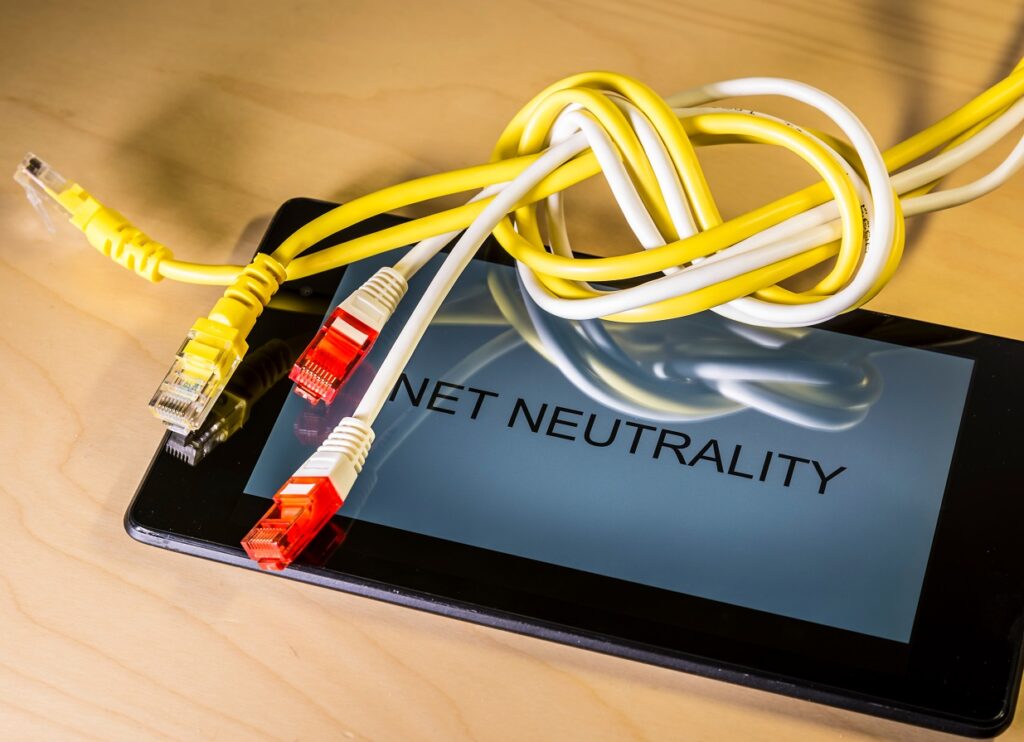Federal Communications Commission (FCC) Chair Jessica Rosenworcel on Tuesday announced the agency’s proposal to regulate internet services under Title II of the Communications Act. Commonly referred to as “net neutrality,” the chair plans to release proposed rules today, with a vote scheduled for Oct. 19 to begin the rulemaking process.
Rosenworcel’s speech identified several areas the FCC intends to regulate under Title II:
- Blocking, throttling, and censorship: “[Y]our broadband provider has no business cutting off access to websites, slowing down internet services, and censoring online speech.”
- Paid prioritization: “Your broadband provider was not allowed to play favorites like steering you fast to some online service that had given them a payout and assigning you to a bumpy road for those who had not offered up the same pay.”
- Monopoly: “That provider may be the only game in town. You need a referee on the field looking out for the public interest. And ensuring that access is fast, open, and fair”
- Outage reporting: “Title II would also bolster our authority to require internet service providers to address internet outages.”
- National security: “Today, when we take away authorization to provide service in the United States from state-affiliated companies who may wish to do us harm, we take away what is known as Section 214 authority. But remember, thanks to the retreat from Title II in the last administration that authority does not cover broadband.”
- Cybersecurity standards: “[W]ithout reclassification the FCC has limited authority to incorporate updated cyber security standards into its network policy.”
- Privacy: “That means these providers cannot sell your location data among other sensitive information. These privacy protections currently extend to phone service customers but not to broadband subscribers because Title II does not cover the latter.”
- Pole attachments: “Title II gives cable and phone companies rights to attach their facilities to utility poles when they deploy service. When the FCC rolled back its open internet rules, it eliminated the pole attachment rights of broadband-only providers.”
- Robocalls/texts: “Title II authority would give us the maximum flexibility to counter this fraud and evolve our approaches as technology changes.”
- Preemption of state policies: “But when Washington withdrew, California rode in with its own regime. Other states too. … But when you are dealing with the most essential infrastructure in the digital age, we benefit from having a national policy.”
The chair acknowledged it already can address many of these issues, but that that “can require duct tape and bailing wire to jerry-rig the justifications to make sure all our actions are on sound legal footing.” In contrast, she contends that Title II acts like a magic wand that allows the FCC to impose policies without additional legal justification:
Title II took on special importance in the net neutrality debate because the courts have ruled that the FCC has clear authority to enforce open internet policies if broadband internet is classified as a Title II service.
President Joe Biden has already expressed some interest in broadband price controls. For example, Biden’s 2021 American Jobs Plan called on Congress to reduce broadband prices:
President Biden believes that building out broadband infrastructure isn’t enough. We also must ensure that every American who wants to can afford high-quality and reliable broadband internet. While the President recognizes that individual subsidies to cover internet costs may be needed in the short term, he believes continually providing subsidies to cover the cost of overpriced internet service is not the right long-term solution for consumers or taxpayers. Americans pay too much for the internet—much more than people in many other countries—and the President is committed to working with Congress to find a solution to reduce internet prices for all Americans. (emphasis added)
Against this backdrop, Rosenworcel addressed rate regulation head-on:
Having gone through this drill before I know there’s a small but vocal chorus of naysayers who is surely already raising their objections. They say Title II is heavy-handed. And if we are seeking comment on anything like applying Title II broadband in its entirety I would say they have a point. But we’re not doing that. We’re approaching it with a light touch. Back in 2015, when the FCC last had net neutrality policies upheld by the courts, the FCC chose to forebear from 27 provisions of Title II of the Communications Act and over 700 agency regulations for broadband and broadband providers. We are sticking with that approach. They say this is a stalking horse for rate regulation. Nope. No how, no way. (emphasis added)
Geoffrey Manne, Kristian Stout, and Ben Sperry point out that rate regulation is one of the defining features of most Title II services. Rosenworcel’s promise that “no how, no way” would the FCC regulate rates echoes Obama-era FCC Chair Tom Wheeler’s 2015 promise to forebear from rate regulation under the original Open Internet Order (OIO), declaring “we are not trying to regulate rates.”
But then-Commissioner Ajit Pai’s dissent from the OIO saw these statements as a hedge that left open the likelihood of future rate regulation:
The plan is quite clear about the limited duration of its forbearance decisions, stating that the FCC will revisit them in the future and proceed in an incremental manner with respect to additional regulation. In discussing additional rate regulation, tariffs, last-mile unbundling, burdensome administrative filing requirements, accounting standards, and entry and exit regulation, the plan repeatedly states that it is only forbearing “at this time.” For others, the FCC will not impose rules “for now.”
For broadband providers, even the threat of FCC rate regulation could chill massive amounts of investment and stifle network buildout.
Banning Paid Prioritization Is Rate Regulation
But it’s more than a mere threat. Rosenworcel was clear that the FCC seeks to ban paid prioritization. As Manne, Stout, and Sperry note, such a ban is rate regulation:
The 2015 Open Internet Order’s ban on paid prioritization, couched at the time in terms of “fairness,” was itself effectively a rate regulation that set wholesale prices at zero. The order even empowered the FCC to decide the rates ISPs could charge to edge providers for interconnection or peering agreements on an individual, case-by-case basis.
Regulating Single-Provider Markets Is Also Rate Regulation
In her speech, the FCC chair remarked:
But I also recognize the high cost of entry makes competition a challenge in many places. That is why almost half of us have high-speed service with 100 megabits per second download speed and only half of us can get it from more than a single provider. Only one-fifth of the country has more than two choices at this speed. So if your broadband provider mucks up your traffic, messes around with your ability to go where you want and do what you want online, you can’t just pick up and take your business to another provider. That provider may be the only game in town. You need a referee on the field looking out for the public interest. And ensuring that access is fast, open, and fair. (emphasis added)
First, her statistics do not comport with the FCC’s own assessment of competition. According to the FCC’s most recent information on fixed broadband deployment:
- 94% of the U.S. population has access to 100/10 Mbps broadband;
- 62% have access to those speeds from two or more providers; and
- 18% have access to those speeds from three or more providers.
Second, and more importantly, without saying so explicitly, the chair is hinting that the FCC will use its Title II authority to regulate pricing—or the factors that affect price—in single-provider markets.
Rosenworcel is correct that the FCC proposal to reclassify internet services under Title II common-carrier law is not a stalking horse for rate regulation. Rather, it is an upfront and earnest indication that the FCC intends to directly and indirectly regulate pricing throughout much of the pipeline that delivers internet services from providers to our homes and businesses.

